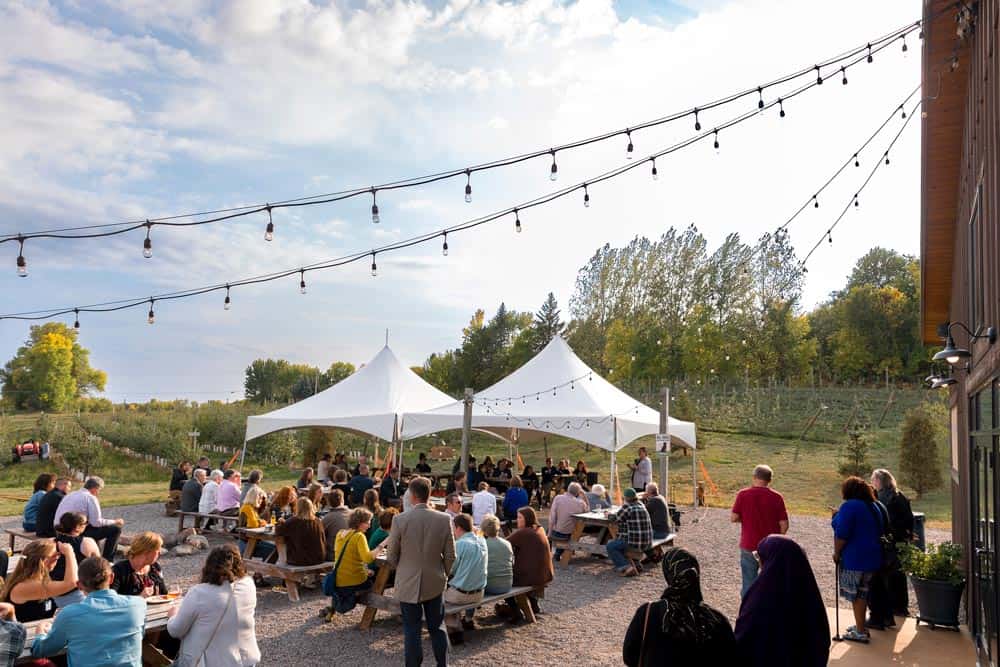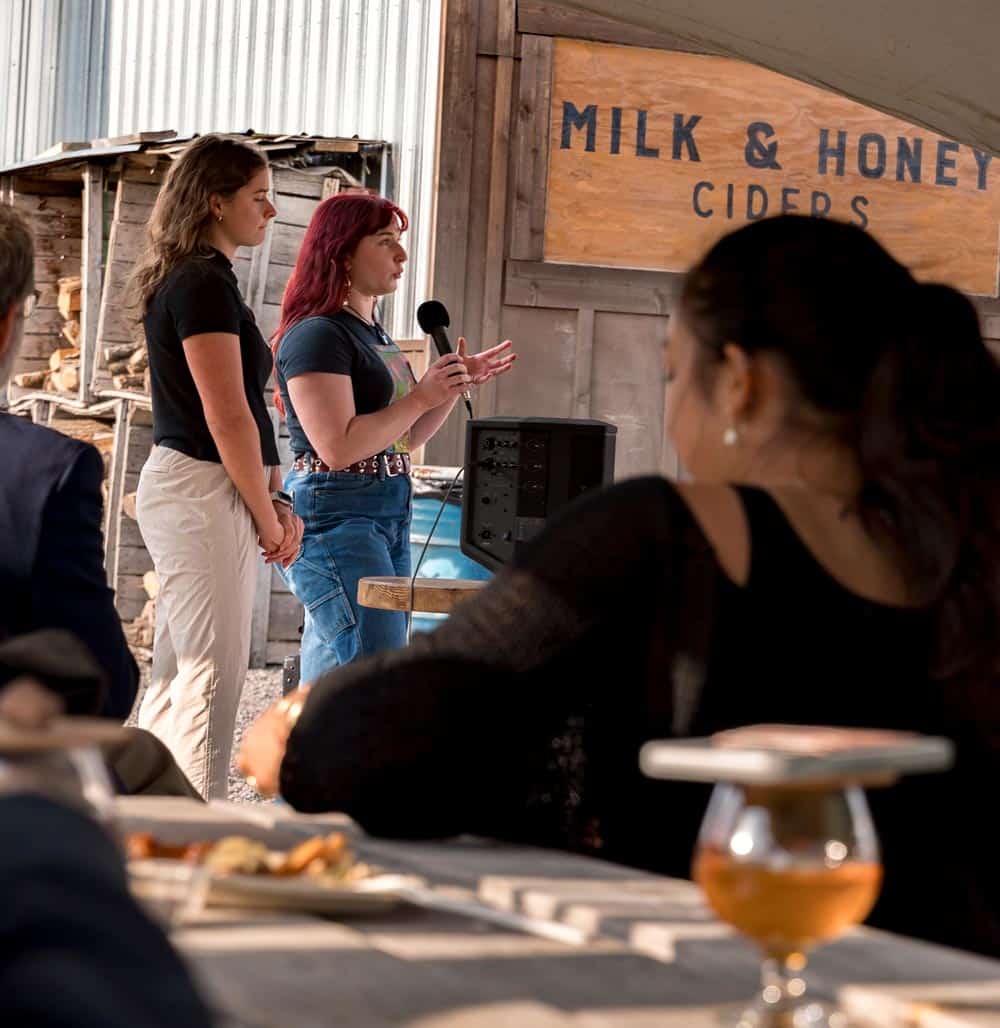The first day of Inauguration Week, celebrating the installation of Brian Bruess, Ph.D., as the first joint president of the College of Saint Benedict and Saint John’s University, began with a spotlight on the schools’ academia.
Five faculty presentations highlighting community-engaged scholarship and creative work kept the crowd buzzing on Monday night (Sept. 18) at Milk & Honey Ciders in rural St. Joseph. Faculty from the nutrition, English, theater, art and global business leadership departments populated “Flourishing Through Scholarship, Creativity, and Partnership with Our Community” while attendees enjoyed a casual social with drinks and appetizers at the cidery and taproom.
Emily Heying, Ph.D., R.D., L.D., an associate professor and department chair in nutrition, led off the presentations with “From Community to Classroom: Building a Collaborative Research Project on Glucose Response to Indigenous-Harvested Wild Rice.” She has overseen the nutrition department’s undergraduate research course experiences since 2018 and two senior nutrition majors (Kalli Anderson of Hopkins, Minnesota, and Savannah Supan from Rice, Minnesota) took the lead on this research with Heying for their senior capstone projects.
The project came to life out of a co-taught course “Native Food Sovereignty,” that Heying taught the past two years with Ted Gordon Ph.D., visiting assistant professor of anthropology. The course focused on topics including Indigenous communities’ history, agricultural practices, the trauma they endured, and the social determinants of health and food access play a role in their health today. One of the primary Indigenous foods is Manoomin, which is hand-harvested wild rice found locally in Minnesota. It is different than the cultivated wild rice sold in grocery stores. Little research exists regarding the satiety and blood sugar response after consuming Manoomin. Gordon suggested the study, with input from his colleagues and collaborators from White Earth Nation.
Information from the study is important because Indigenous populations are at higher risk for insulin resistance and Type 2 diabetes than other racial and ethnic groups in the United States. Increasing fiber intake is one way to support managing blood sugar response and manage diabetes. Manoomin has a higher fiber concentration than white rice, but Heying and her students want to investigate whether the blood sugar response differs between Manoomin and other types of rice of varying fiber concentration. If Manoomin consumption can mitigate blood sugar rise after a meal, the knowledge will provide opportunity for a traditional, Indigenous food to contribute to health. The research also will provide opportunities for students to develop communication and data collection skills with participants and data analysis practice. Heying and her students eagerly await the data collection and analysis for the project and gave listeners a sneak peek at what they’re trying to accomplish. (Anderson and Supan will present results of their research next spring at the annual Creating Scholarship & Creativity Day.)
Chris Bolin, an assistant professor of English, followed with a presentation on “Writing Across the Gaps: Community-based Narrative Practice” before participants took a short break to mingle.
Three presentations of creative work wrapped up the evening. A group of CSB and SJU theater students, under the direction of Kaarin Johnston, Ph.D., performed a scene from “Research in Practice: Dead Man’s Cellphone.”
Steven Lemke, environmental artist-in-residence and associate director of The Saint John’s Pottery, followed with “Environmental Art, Mentorship and Vocation at CSB/SJU.” Lemke, who teaches sculpture, architecture and design, produces mixed-media sculpture and installation art that examines residential land use and its impact on the natural environment. Through research, community-engaged practice, and digital fabrication technology, his artwork collectively asks how we locate ourselves within the increasingly built world, thereby inviting viewers to re-evaluate their perspective on these issues through a lens of criticality.
Operating within the context of a liberal arts institution with a rich and dynamic history of environmentally engaged creativity, the work of being an environmental artist-in-residence is to inspire and support undergraduates in discovering their own creative vocations so that CSB and SJU graduates enter the workforce prepared to sustain their creativity. Lemke discussed two recent projects: a 25-day design intensive in which he took part with internationally acclaimed architect Steven Holl in New York, and an ongoing summer research project as a guest artist of the St. Croix Watershed Research Station, part of the Science Museum of Minnesota in St. Paul.
With contributions from his interns, CSB students Mahina Melim, Taylor O’Brien and Josephine (Josie) Meyer, he connected his work to the everyday experience of students through the new Environmental Art Internship Program, which supports Bennies and Johnnies with creative and environmentally focused professional interests through one-on-one mentorship, studio work and career coaching. The initiative reimagines how we mentor undergraduates in the visual arts regardless of major, guiding liberal arts students toward creative vocations across disciplinary boundaries and using practical skills to address urgent issues in our world.
Frank Plachecki, Ph.D., a visiting assistant professor of global business leadership, then concluded the event with keyboard performances of “Prelude in C Major,” his own arrangement, and “Lake District” (by Staffan Scheja).
The program at Milk & Honey Ciders capped a day that also included campus cleanup events at Saint Ben’s and Saint John’s, the first “Explore Campus Hidden Spaces” events – which will continue all week, a peace studies showcase, and the first clue in a community medallion hunt.
Other Inauguration Week events will be every day through the weekend, including Bruess’ inauguration ceremony at 2 p.m. Friday at the Saint John’s Abbey and University Church.

Emily Heying presents background on a research project she and several students are working on regarding a study of Indigenous uses of and benefits from wild rice.

Kalli Anderson (left) and Savannah Supan present their research on Indigenous uses of wild rice to the crowd on Monday (Sept. 18) at “Flourishing Through Scholarship, Creativity, and Partnership with Our Community.”

Steven Lemke (right) makes a presentation about environmental art, mentorship and vocation.
